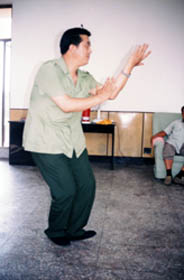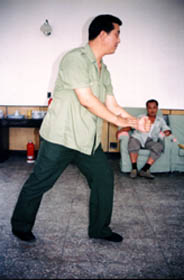|
|
|||||||||||
|
|
|||||||||||
 |
|||||||||||
|
|
|||||||||||
|
![]()
|
Dai Family Xinyiquan - Technical Characteristics Part One by Jarek Szymanski |
| Text and photos - Jarek Szymanski; © J.Szymanski 1999-2002 |
|
|
|
Dai Family Xinyiquan, as already mentioned in the article about its origins and development, is very interesting for researchers because of its historical connection with Xingyiquan. However technical features of both styles show almost no relationship between them. This has always been a very contentious issue - while Dai Family Xinyi practitioners have usually been looking down at Xingyi, Xingyi exponents are saying that nobody would know about Dai Family Xinyi and Dai Longbang if Li Laoneng and his students had not become famous fighters. Dai Family Xinyiquan has been kept secret until early 1980s, and after almost twenty years of its opening to the outside world there are still very few people who would talk about it openly and share their knowledge with outsiders. Traditionally one would start learning the style from its basic exercises. These exercises differ a lot from methods used in other Neijia styles. Basics:
|
|
The practice of Dai Family Xinyiquan starts from its most important and most secret standing exercise - Squatting Monkey Stance (Dun Hou Shi). It is called so because of its similarity to a standing monkey, waiting and looking around with attention. Usually beginners stand in a squatting position for extended periods of time to strenghten legs and sink down Qi. After that, they practice this method in movement - squatting and straightening up. Body should be relaxed, breathing natural, movement very slow. The exercise, although looks simple, is in fact very complicated - there are many specific requirements for all parts of the body and overlooking any of them may not only hinder one's progress, but also be harmfull, especially because of vertical movement of backbone on its whole length. The key to proper practice is understanding of "Three Curves Gathered Together" (San Yuan Ju Yi), e.g. correct alignment of lower, middle and upper part of the body. The goal of the exercise is to acquire the ability to Contract (Shu) and Expand (Zhan) body and to develop Dantian. For this reason it is also called Shen Fa (Body Method) or Nourishing Dantian (Yang Dantian). |
Squatting Monkey Stance (Dun Hou Shi) should be practiced from early childhood |
|
|
|
Once the Dantian develops and acquires required hardness, one can start further Dantian exercises that include Pounding Dantian (Za Dantian), Discharging Dantian (She Dantian) and others. Their goal is to learn how to use Dantian for driving the body and power emission. The process of Dantian development is very long and usually takes at least three years before one can proceed to the next step, e.g. Footwork Method (Bu Fa). However, since Dantian practice is the core of Dai Family Xinyiquan, even very advanced practitioners do it everyday for extended periods of time. On the other hand such practice leads to skills difficult to acquire in other way. For example, I witnessed a situation when a Xinyi exponent was sitting on a bed cross-legged and used Discharging Dantian method to jump one feet high. Dai Kui is said to have been able to jump in this way from one chair to another across a table. True or not, discharging with Dantian is the most powerful weapon of Dai style. |
|
Footwork Method (Bu Fa) of Dai Family Xinyiquan uses bow stance, called here Hu Bu - Tiger Step |
Footwork Method (Bu Fa) uses Dantian rotation principle (e.g. Contracting and Expanding) accompanied by certain footwork - Cun Bu (Inch Step), Dingzi Bu (Character "Ding" - similar to "T" Step) and Hu Bu (Tiger Step, e.g. bow step, Gong Bu). This is another feature of Dai Family Xinyiquan - using bow step (Gong Bu) and not Santi-based footwork. This is because correct and complete Dantian rotation can only be achieved in bow step. One learns not only to move forward, but also to retreat. The exercise should also be performed very slowly, although one can add some power emissions, which are called Fast Power (Kuai Jin). Because of health considerations, for one fast movement with power there should be at least three slow, "nourishing" movements. One should practice Bu Fa for at least two years before learning Five Elements Fists (Wu Xing Quan). Hence the whole basic process takes at least five years (San Nian Zhuangfa Liang Nian Bu - Three Years of Standing Two Years of Walking). However without these basics there is no true skill in Dai Family Xinyiquan and trying to skip this period and advance towards combat techniques would lead to nothing. For this reason Dai family Xinyiquan seems to be very difficult to promote and popularize. Even within traditional Xinyi community in Shanxi there are many who practiced hard for long time and still failed to acquire decent Dantian skill. |
|
|
|
|
Technical material of Dai Family Xinyiquan includes:
Five Elements Fists carry identical names as their counterparts in Xingyiquan, i.e Pi Quan (Chopping Fist), Beng Quan (Crushing Fist), Pao Quan (Cannon Fist), Zuan Quan (Drilling Fist) and Heng Quan (Horizontal Fist), but are different. They are performed slowly using Dantian rotation in a round and relaxed manner. Movement is compact and completed within one Contraction and Expansion like a wave in one step as in Stepping Method. One can perform Pi Quan while moving forward and retreating, as well as using Lower Basin Step (Di Pan Bu) beneficial for leg power. Usually one starts from Pi Quan (Chopping Fist), and only later slowly proceeds to next techniques. |
| Pi Quan (Chopping Fist) -
Contraction (Shu) 1 |
Pi Quan (Chopping Fist) -
Expansion (Zhan) 2 |
Since Pi Quan is considered to be most basic technique within Dai Shi Xinyi system, some practitioners focus only on it without learning anything else. Very often their skill is superior to their brothers who study many techniques. This conforms with general principle of "few movements but mastered to perfection" (Shao Er Jing). Every Element is composed of multiple powers which determine its martial applications. For example Pi Quan includes five vertical powers: Peng (Push Upwards), Duo (Picking Up), Gou (Hooking), Pi (Chopping), Za (Smashing) and two horizontal ones: Gun (Rotating) and Cuo (Cutting). Rhymed formulas for each Element are different from their Xingyi counterparts. |
 |
 |
|
|
Taking again Pi Quan as example: "Chopping Fist is like an axe and belongs to Metal but it is not an axe; it has a posture of taking and pushing a plate upwards".
|
End of "Dai Family Xinyiquan - The Technical Characteristics (Part One)"; © J.Szymanski 1999-2002 THE NEXT ARTICLE WILL DESCRIBE THE SECRET INTERNAL METHOD OF DAI FAMILY XINYIQUAN WITH MANY DETAILS TO BE REVEALED FOR THE FIRST TIME |
Home ▪ About me ▪ Updates ▪ Taiji ▪ Bagua ▪ Xinyi-Xingyi ▪ Other Styles ▪ News ▪ Store ▪ Community ▪ Email